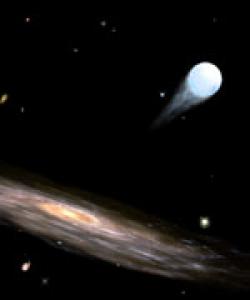A star that apparently had a close encounter with the black hole at the center of the Milky Way is now speeding out of the galaxy at some 1.5 million miles per hour. That’s the conclusion of astronomers at the Harvard-Smithsonian Center for Astrophysics (CfA), who say the star is moving fast enough to have achieved galactic escape velocity. “We have never before seen a star moving fast enough to completely escape the confines of our galaxy,” said co-discoverer Warren Brown (CfA). “We’re tempted to call it the outcast star because it was forcefully tossed from its home.”
 The star is catalogued as SDSS J090745.0+24507; it was apparently a member of a binary system before its close brush with the black hole. According to the scientists’ scenario, the companion star was pulled into orbit around the black hole while the outcast star was flung on a trajectory that will take it out of the galaxy entirely.
The star is catalogued as SDSS J090745.0+24507; it was apparently a member of a binary system before its close brush with the black hole. According to the scientists’ scenario, the companion star was pulled into orbit around the black hole while the outcast star was flung on a trajectory that will take it out of the galaxy entirely.
Image: Astronomers at the Smithsonian Astrophysical Observatory have discovered the first star flung out of the Milky Way, speeding away at over 1.5 million miles per hour. This tremendous speed likely resulted from a close encounter with the massive black hole at the center of the Milky Way. The so-called outcast star is shown in this artist’s depiction in its current location as it travels through the distant outskirts of the Milky Way. Credit: Ruth Bazinet, CfA
From a CfA press release:
Its composition and age provide additional proof of the star’s history. The fastest star contains many elements heavier than hydrogen and helium, which astronomers collectively call metals. “Because this is a metal-rich star, we believe that it recently came from a star-forming region like that in the galactic center,” said Brown. Less than 80 million years were needed for the star to reach its current location, which is consistent with its estimated age.
The paper outlining the find (with co-authors Margaret J. Geller, Scott J. Kenyon and Michael J. Kurtz) will appear in The Astrophysical Journal.

